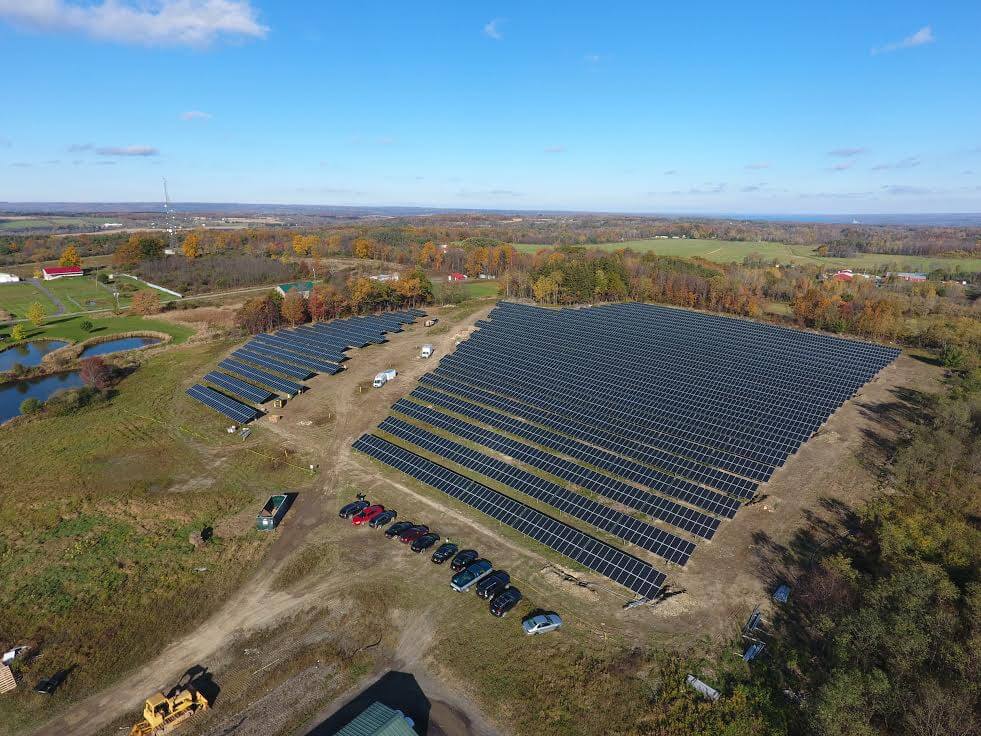Growing Upstate New York’s community solar industry, BlueRock Solar – a Syracuse, N.Y.-based division of energy supplier BlueRock Energy – is in the process of building the Grand Island community solar farm, which will be capable of producing 2.1 MW of power once it’s completed.
Even though U.S. community solar capacity more than doubled between 2016 and 2017, it still makes up just a tiny portion of the total solar market, according to recent findings from the Smart Electric Power Alliance (SEPA). In total, according to SEPA’s report, at the end of 2017, there were 228 utilities in 36 states with active community solar programs. However, the projects comprised only a little more than 1% of the total U.S. solar market, the alliance said.
With the help of friendly local policies, funding support and its parent company’s long-time experience in the Northeast, BlueRock Solar says the Grand Island project will be its third community solar farm in New York State, which is mandated to procure 50% of its electricity from renewable sources by 2030.
Slated to begin operations this fall, BlueRock’s new project is being built in partnership with Active Solar Development LLC, an engineering, procurement and construction contractor headquartered in Galway, N.Y. The 18-acre project, comprising 6,000 panels, is located in the Town of Grand Island, which is situated between Buffalo and Niagara Falls.
Michael Francis, general manager of BlueRock Solar, tells Solar Industry the company chose Grand Island for a few reasons: e.g., the town’s “good utility infrastructure” and the bonus funding opportunity from the New York State Energy Research Development Authority (NYSERDA) because of the project’s location in a “strategic zone.” Importantly, the town has also been “very supportive of community solar,” he says.
For example, spearheaded by the town’s government, the Solarize Grand Island initiative – which the Grand Island project is “indirectly connected to,” notes Francis – is “designed to reduce the price of solar for Grand Island residents and businesses through group-purchasing of solar installations between May 12 and Sept. 3, 2018,” according to the campaign’s description.
To further the campaign, the town also hosts events to educate residents on the benefits of going solar. Francis explains that BlueRock gave a presentation at a town event in order to give Grand Island residents “priority access” in signing up for power from the new community solar farm.
Following a “great turnout” in the town, according to Francis, BlueRock then opened up enrollment to the “public at large,” which is anyone located within the project’s utility load zone (and for the same utility).
“For our project, you need to be in load zone A, and you have to have National Grid as your utility provider,” says Francis. “The eligible customer base is fairly large; it’s pretty substantial.”
And to sign up for the project, the process is simple, he explains:
“We have a website that they go to; they enter in their utility information; and they decide whether they want to sign up for a one-, two- or three-year term, and from there, we look up their usage, and from that, we are able to give them a percentage of the project that they’re signing up for.”
The beauty of the subscription-style contract is that purchasers do not have to commit to a long-term deal, do not have to put down an upfront investment, and do not need to go through a credit check – a system ideal for residents such as renters or those who move around a lot, says Francis.
The result? Savings on their utility bill, which BlueRock estimates could be up to 5% less than the current National Grid delivery rates.
The company’s first community solar project, a 642 kW facility located in central New York’s Millport, was interconnected in April 2017 and represented the state’s first community solar project that had a “subscription-style, pay-as-you-go” model, according to Francis.
In January 2017, Francis said, “No longer is the population of renters, homeowners with an unsuitable roof, or those unable to afford a solar system shut out of the benefits of going solar. Instead of placing panels on individual roofs, residents share the power generated by the project, paying as they go, while enjoying energy cost reductions.”
That sentiment still holds true for the company, which also interconnected a 2.7 MW community solar project in Ithaca, N.Y., in December 2017.
In order to have a successful community solar model, though, Francis brings up what he says is “one of the very important components”: customer acquisition.
BlueRock Solar’s parent company – BlueRock Energy, the official electricity provider of the NFL’s Buffalo Bills – has more than 21,000 customers in five Northeast states, he says, allowing BlueRock Solar to “have the embedded infrastructure that is required to acquire the customer, bill and collect the customer, and interface with the utility.”
Compliance is another important component, Francis adds: “You need to have a compliant contract and uniform business practices.”
BlueRock Energy, whose mission is to offer “supplier options beyond those offered directly by the utilities,” got into community solar because it “saw the writing on the wall,” says Francis.
Now, the company has a pipeline of other projects in the works and is not ruling out expanding to states beyond New York, he adds.
“We got into it early, we proved the concept out,” Francis says, “and now we’re slowly but surely adding to our portfolio.”
Photo: BlueRock’s community solar project in Ithaca, N.Y.




